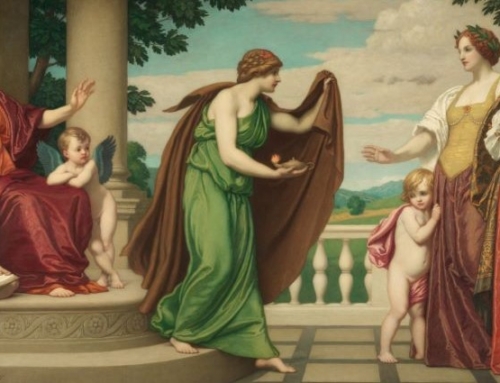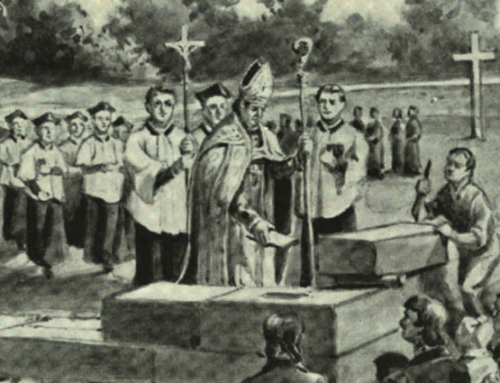While science and religion have differences that need reconciliation, you can regard the so-called ‘war’ between them as ‘fake.’ The history of science is entwined with our human search to discern a deeper understanding of our purpose within the universe….
 Alan Honour begins his book Cave of Riches: The Story of the Dead Sea Scrolls with how young Muhammid Ahmed el-Hamed (of the Ta’amireh Bedouin tribe) was searching for his stray goat when he stopped to throw a rock in a hole. He heard the rock shatter something that sounded like pottery, and this near-aimless act led to what might be the greatest discovery of the 20th century.
Alan Honour begins his book Cave of Riches: The Story of the Dead Sea Scrolls with how young Muhammid Ahmed el-Hamed (of the Ta’amireh Bedouin tribe) was searching for his stray goat when he stopped to throw a rock in a hole. He heard the rock shatter something that sounded like pottery, and this near-aimless act led to what might be the greatest discovery of the 20th century.
A second remarkable story is less dramatic, but its implications are almost as important as the first. According to Honour, archaeologists at the Wadi Qumran dig sent a piece of linen cloth that they found in one of the excavated rooms to Dr. Willard F. Libby at the Institute for Nuclear Studies at the University of Chicago for Carbon-14 dating. These scientific tests proved that the Dead Sea Scrolls were at least a thousand years older than the oldest known biblical manuscript of that time.
The discovery of the Dead Sea Scrolls, left behind by the ancient Essenes at Wadi Qumran (in what is today the disputed West Bank area), meant that an issue of faith suddenly became strengthened by facts. The scrolls affirmed the accuracy of many Old Testament books in the Bible. More than this, the discovery at Wadi Qumran ended much of the debate surrounding the historical authenticity of the Bible. Dr. Libby’s accurate Carbon-14 tests proved that the oldest scrolls dated back to the Hellenistic era of the Second Temple, perhaps 250 years before the birth of Jesus, and thus could not have been concocted by partisans of Jesus to retroactively prove his messiahship. This is what critics in both learned and fashionable circles often claimed.
Alan Honour’s story of the Carbon-14 dating of the Dead Sea Scrolls illustrates that if you are a religious person, if faith is an extension of who you are, then you should consider studying the sciences. Whether you are struggling with choosing biology or social psychology as an academic major, or contemplating the further development of an amateur (from the French, ‘lover of’) interest in space engineering or environmental studies, the sciences have much to offer a person of faith.
Has someone told you that science is anti-religion or religion is anti-science? Do not allow this to dissuade you. Many who profess to be ‘pro-science’ cannot tell you the difference between carbon monoxide (a poisonous exhaust) and carbon dioxide (a naturally-occurring gas that is an important resource for botanical life on this planet). Likewise, cultural religionists who discourage honest inquiry forget that all faith deals with questions of purpose and existence.
As a religious person, University of Chicago professor Wayne C. Booth argues that you have more in common with scientists than you realize. In his book The Rhetoric of Rhetoric, Booth draws on his experience as a literary critic and teacher of rhetoric to argue that there were seven ‘warrants’ (or common assumptions) that scientists share with religious people.
Warrant One: The Flawed World
Most religions agree that something has gone wrong with creation, and science has its own version of The Fall. As Booth puts it, “The world as we experience it is somehow flawed.” Prince Hamlet asks this existential question for all human beings: “And yet, to me, what is this quintessence of dust?“
Shakespeare echoes the questions of religious people who must simultaneously acknowledge the marvelousness of creation with its fallenness. Similar to Hamlet, the awareness of flaws leads scientists to ask existential questions: What is the universe made of? What is consciousness? What distinguishes human beings from the rest of the animal kingdom?
Warrant Two: The Measure of All Things
According to Booth, religious persons and scientists think that “flaws are seen in the light of the Unflawed,” which means that “standards of judgement of the brokenness exist somewhere.” For monotheistic religions, God is the standard for his fallen creation, but scientists have their own measure of comparison. What the ‘unflawed’ means for a scientist is that we learn what is wrong with a diabetic body by contrasting it with a nondiabetic body, an unsanitary environment with a salubrious one, and so forth. However, as a 1971 social psychology experiment gone wrong illustrates, a person can also embody truth for a scientist.*
When psychologist Philip Zimbardo was conducting his famous Stanford University prison experiment, he invited fellow psychologist (and future spouse), Christina Maslach, to observe and interview the participants. The experiment involved two dozen Stanford students who were assigned roles as either prisoners or guards. Zimbardo was studying “the power of social roles to diminish the sense of personal identity.” But on that evening, Zimbardo’s girlfriend provided insight into his flawed experiment.
When Maslach arrived at the mock dungeon in the basement of the psychology building, she saw that the experiment was out of hand because the role-playing ‘guards’ were abusing the student ‘prisoners.’ Five students had already left the study because of psychological breakdowns. When she saw that her boyfriend was allowing the travesty to continue, Maslach almost ended her relationship with Zimbardo and explained to him that he had failed in his obligations as a boyfriend and a scientist.
That evening, as the guards placed bags over their prisoners’ heads, chained them together, and marched them to the bathroom, Zimbardo watched Maslach’s eyes fill with tears. He was shocked. “I say, what’s the matter? And she says, ‘It’s just terrible what you’re doing to these boys!’ I didn’t get it at all at first. I had so much invested in the research, I had been watching it progress over the course of days, and I was on autopilot. I couldn’t see what was wrong with it…”
Through a combination of love and objective insight, Maslach became an embodied standard for Zimbardo, who then chose to end his experiment. None of this is much different from how a priest, rabbi, or Tibetan monk can personify universal values for their congregations, or how the risen Jesus personifies a standard of compassion and right living for Christians.
Warrant Three: Behold, it was Very Good
C.S. Lewis argues in Mere Christianity that
If the whole universe has no meaning, we should never have found out that it has no meaning; just as, if there were no light in the universe and therefore no creatures with eyes, we should never know it was dark. Dark would be without meaning.
Similar to Lewis, Booth argues that Warrants One and Two depend on there being “some supreme order or cosmos or reality, something about the whole of things that provides the standards” for how a scientist makes sense of nature. Indeed, the fields of physics and chemistry deal with balances in nature that form standards for the universal laws that are the basis for laser experiments or the periodic table.
Such scientific order can be fascinating and even beautiful, which Walt Disney in his 1957 film Our Friend the Atom captures in an illustration of how nature maintains an atomic balance between electrons and protons in each element.
Warrant Four: The Beam in Our Eye
Booth argues that both scientists and religious people “see themselves as in some inescapable sense a part of the brokenness.” Saint Paul says everyone has fallen short of God’s standard, and many scientists worry about the harm their studies or experiments might cause, despite their good intentions.
Precautions are taken to minimize such problems, but this preoccupation with themselves as ‘part of the brokenness’ goes deeper for scientists. Recently, a scientist who specializes in environmental biology told me of his dilemma: studying nature can mean polluting it. To reach the wildlife reservations that are miles from his University, he needs a car. To cover some of these vast open spaces, he needs not merely a high-performing vehicle, but roads and walking trails that intrude into the very pristine wilderness that he wants to conserve. In other words, scientists must balance their need to gather information (to answer their questions) with their own ‘inescapable sense’ that they could be causing a problem.
Warrant Five: We Are Called
Saint James cautioned the Church in Jerusalem about “being a hearer of the word, and not a doer.” Likewise, Booth argues that scientists experience a similar calling: “The cosmos… calls upon me to do something about the brokenness.” While the mad scientist is a popular motif in novels and movies, so is the heroic scientist who is selfless to a fault; a few of these characters are David Bowman in the Space Odyssey stories, Eleanor Arroway in Contact, and Dr. Dan Gunn in Alas, Babylon.
Warrant Six: Deny Ourselves
Similar to the Gospel of Matthew where Christians are told to ‘deny themselves,’ Booth argues that scientists are guided by a similar principle: “Whenever my notion of what my cosmos requires of me conflicts with my immediate wishes or impulses, I ought to surrender to that higher value.” Your belief still has value, and one day—if you sedulously conduct your research—it might become a scientific truth. Yet for the time being, you must accept the research before you. As a science professor colleague of mine phrased it, “My idea might be this, but, for now, the evidence says otherwise.”
Warrant Seven: All Things New
Booth argued that both religious persons and scientists share a sense of catharsis: “emotional feelings connected” to their worship or research. Likewise, psychologist Andy Tix contends that feelings of ‘awe’ and wonder are at the very heart of both the religious and scientific experience: “Science is increasingly documenting the connection between awe and spiritual virtues and behaviors, including patience, generosity, compassion, humility, belief, and wisdom.” (For an example of ‘awe’ within a scientific outlook, you should watch Erik Wernquist’s short film Wanderers.)
One of my students—whose parents are scientists but also religious—told me this video made her “feel small, but not in a bad way.” This is an apt description of how feelings of ‘awe’ affect both scientists and religious people.
As Wernquist takes you through the worlds of our solar system, you might feel a sense of preternatural awe and amazement. As you watch the cosmic wanderers traverse the moons and planets, perhaps you will feel a connection to the narration of Carl Sagan: “Your own life, or even your own species’ might be owed to a restless few—drawn, by a craving they can hardly articulate or understand, to undiscovered lands and new worlds.”
Science and religion were intended to interact!
While science and religion have differences that need reconciliation, you can regard the so-called ‘war’ between them as ‘fake.’ The history of science is entwined with our human search to discern a deeper understanding of our purpose within the universe. Even to a mercurial nonbeliever like Stephen Hawking, the thought of “philosophers, scientists, and just ordinary people” working together to reach the answer for “the question of why it is that we and the universe exist” would be like to “know the mind of God.”
If you want to come closer to God, the study of the sciences can, as the philosopher John Locke wrote, bring you to the “visible marks of extraordinary wisdom and power” that “appear so plainly in all the works of creation that a rational creature…cannot miss the discovery of a Deity.” The chemist and natural philosopher Robert Boyle claimed that “From a knowledge of His work, we shall know him.” The biologist Louis Pasteur said that “Science brings men nearer to God” and that the more he studied nature, the more amazed he became with its Creator.
A study of science that leads to God is no accident because, as the medieval poet Dante Alighieri said, nature is “the art of God.” Science began as the process for the study of this divine canvas. The painter and inventor Leonardo Da Vinci said that God gave us everything “at the price of an effort,” which is the underlying motive for all science.
Through this effort, we are closer to the mind of God than we have ever been. Whether you make science your profession, or join the ranks of thousands of devoted amateurs in pursuit of this remarkable knowledge, use this magnifying glass to trace the brushstrokes of The Divine Canvas.
Originally republished here October, 2018 with gracious permission from the Carolina Institute for Faith and Culture (November 2017).
The Imaginative Conservative applies the principle of appreciation to the discussion of culture and politics—we approach dialogue with magnanimity rather than with mere civility. Will you help us remain a refreshing oasis in the increasingly contentious arena of modern discourse? Please consider donating now.
Note:
*Read about the experiment here.
Editor’s Note: The featured image is “The Scientist,” by Richard Linderum.







Leave A Comment